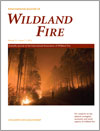International Journal of Wildland Fire
Volume 21
Number 7 2012
This paper reviews over 100 years of observations and studies of how the atmosphere interacts with wildland fires. It examines surface atmospheric properties, vertical atmospheric structure and synoptic systems in turn. It synthesises the literature and identifies knowledge gaps.
This paper reviews over 100 years of observations and studies of how the atmosphere interacts with wildland fires. It examines fire vortices and plume dynamics, synthesising the literature and identifying knowledge gaps.
Fires in Siberian forests, which burn 10–14 × 106 ha annually, emit 3–10 × 106 t of smoke particulates. The fine particles of 0.1–5 μm in size remain in the air for a long time, and absorb and scatter solar radiation, resulting, possibly, in weather and climatic change.
The combined effects of wind, slope and fire size were investigated with the physically based model FIRETEC. This study identifies configurations where current operational models could fail to predict hazardous fire behaviour.
The interaction between two linear fire fronts making a small angle between them is a source of strong convection and radiation activity and is characterised by a very rapid advance of the intersection point of the two fires, creating concern for personnel and property safety, especially in large-scale fires. This fire, which is designated ‘jump fire’, was investigated experimentally at a laboratory scale and an analytical model is proposed to predict this behaviour.
Literature was reviewed about the effects of prescribed burning on surface runoff and erosion, with particular emphasis on the influence of fire regime characteristics. Two future research directions are recommended: (1) process-based studies to understand the factors controlling surface runoff and erosion; and (2) landscape-scale surveys to quantify large erosion events.
Many of Mexico’s oak and pine species are found in fire-prone environments. Post-fire responses (top-kill, tree mortality and resprouting) were studied. The results are useful for understanding the important role of fire in maintaining certain ecosystems and provide land managers with information on expected recovery after wildfire.
This manuscript introduces a new approach to relating forest fuels and fire behaviour in the grassy understorey of fire-prone woodlands. This study illustrates the importance of fuel composition and spatial connectivity in driving fire behaviour and has implications for learning about fire behaviour influence on future plant composition and distribution.
Through laboratory desorption experiments, we determined that fractured shrub particles from mastication fuels treatments do not dry faster than non-fractured particles in dense fuelbeds composed of equal fuel loading by diameter class. However, drying rates of fuelbeds were much slower than particles drying at their surface, indicating a propensity for moisture retention in these fuelbeds.
The paper examines the link between location of fires and cause of their ignition. The work uses historical records of fire ignition in Catalonia for the period 1995–2006. The results show that the activity of arsonists is clustered, providing an opportunity to optimally allocate law-enforcement resources within fire hotspot areas.
We compared two groups of survivors interviewed after the 2009 Victorian wildfires: those who stayed and defended, and those who left. The major determinant of staying and defending was prior commitment to this plan; the major determinant of leaving was a trigger event that confirmed that the fire posed a severe threat.




